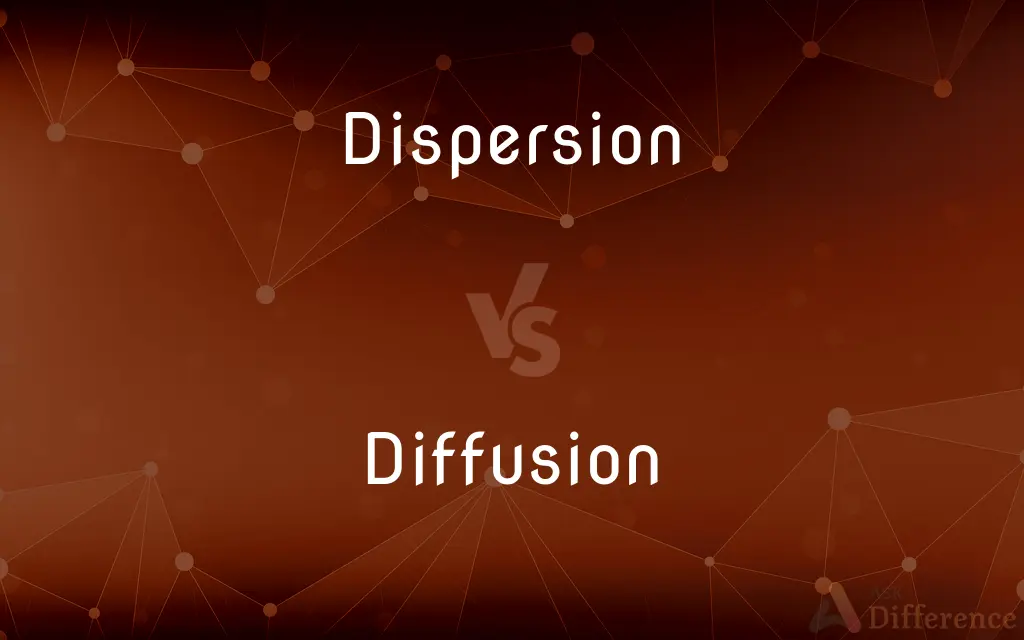Dispersion vs. Diffusion — What's the Difference?
Edited by Tayyaba Rehman — By Maham Liaqat — Updated on April 25, 2024
Dispersion is the process by which particles are spread out, typically through a medium, due to physical forces, whereas diffusion is the movement of particles from areas of higher concentration to lower concentration, driven by thermal energy.

Difference Between Dispersion and Diffusion
Table of Contents
ADVERTISEMENT
Key Differences
Dispersion involves the spreading of particles, light, or other entities through a medium, such as water or air, influenced by physical processes like variation in velocity or direction. Whereas, diffusion specifically refers to the movement of molecules or particles from areas of high concentration to areas of low concentration until equilibrium is reached, primarily driven by thermal motion.
In terms of physical sciences, dispersion can affect various types of waves and particles, resulting in phenomena like the rainbow (through light dispersion) or the mixing of pollutants in air and water. On the other hand, diffusion is a key process in fields like chemistry and biology, crucial for processes such as gas exchange in lungs or nutrient absorption in cells.
Dispersion does not necessarily require a concentration gradient and can occur simply due to differences in physical properties of the medium or external forces. In contrast, diffusion inherently relies on the presence of a concentration gradient and ceases once equilibrium is achieved.
The concept of dispersion is often used in optics to describe how light separates into colors as it passes through a prism, based on different wavelengths traveling at different speeds. Conversely, diffusion is commonly illustrated with examples like the spreading of perfume in a room or the evening out of sugar dissolved in coffee, where particles intermingle until uniformly distributed.
While both dispersion and diffusion involve the movement and spreading of substances, dispersion is governed more by physical forces and properties of the medium, whereas diffusion is a statistical effect resulting from random molecular motion.
ADVERTISEMENT
Comparison Chart
Efinition
Spreading of particles or waves through a medium.
Movement from high to low concentration.
Driving Forces
Physical forces, medium properties.
Thermal energy, concentration gradients.
Applications
Optics, pollution control.
Biological processes, mixing of gases and liquids.
Dependency
Not dependent on concentration gradients.
Dependent on concentration gradients.
Examples
Light through a prism, sound through air.
Perfume in air, sugar in water.
Compare with Definitions
Dispersion
The spreading of objects or particles over an area.
Wind causes the dispersion of seeds away from the parent plant.
Diffusion
The net movement of molecules from high to low concentration areas.
Oxygen diffuses from the lungs into the bloodstream during respiration.
Dispersion
Separation of waves or particles due to varying properties.
Sound waves experience dispersion in different atmospheric conditions.
Diffusion
A process important for mixing substances at the molecular level.
Diffusion is essential for the uniform mixing of ingredients in a solution.
Dispersion
The process of spreading substances through a medium.
Light dispersion occurs when sunlight passes through raindrops, creating a rainbow.
Diffusion
It occurs naturally in gases, liquids, and solids.
Carbon dioxide diffuses out of cells into the surrounding blood vessels.
Dispersion
In physics, it refers to the dependency of wave speeds on frequency.
Dispersion in optical fibers can affect the quality of transmitted signals.
Diffusion
Leads to equilibrium without requiring external energy.
Diffusion will continue until the concentration of a substance is uniform throughout a space.
Dispersion
Generally, it involves the distribution of entities in space.
The dispersion of pollutants in the ocean varies with currents and tides.
Diffusion
Influenced by temperature as it increases the kinetic energy of particles.
Diffusion rates increase significantly with temperature rise.
Dispersion
The action or process of distributing things or people over a wide area
Some seeds rely on birds for dispersion
Diffusion
Diffusion is the net movement of anything (for example, atoms, ions, molecules, energy) from a region of higher concentration to a region of lower concentration. Diffusion is driven by a gradient in concentration.
Dispersion
The separation of white light into colours or of any radiation according to wavelength.
Diffusion
The process of diffusing or the condition of being diffused
The diffusion of new technology around the world.
Dispersion
The extent to which values of a variable differ from a fixed value such as the mean.
Diffusion
The scattering of incident light by reflection from a rough surface.
Dispersion
The act or process of dispersing.
Diffusion
The transmission of light through a translucent material.
Dispersion
The state of being dispersed.
Diffusion
The spontaneous intermingling of the particles of two or more substances as a result of random thermal motion.
Dispersion
Dispersion The Diaspora of the Jews.
Diffusion
The spread of linguistic or cultural practices or innovations within a community or from one community to another.
Dispersion
(Statistics) The degree of scatter of data, usually about an average value, such as the median.
Diffusion
The act of diffusing or dispersing something, or the property of being diffused or dispersed; dispersion.
Dispersion
Separation of a complex wave into its component parts according to a given characteristic, such as frequency or wavelength.
Diffusion
(physics) The scattering of light by reflection from a rough surface, or by passage through a translucent medium.
Dispersion
Separation of visible light into colors by refraction or diffraction.
Diffusion
(physics) The intermingling of the molecules of a fluid due to random thermal agitation.
Gaseous diffusion
Dispersion
(Chemistry) See disperse system.
Diffusion
The spread of cultural or linguistic practices, or social institutions, in one or more communities.
Dispersion
The state of being dispersed; dispersedness.
Diffusion
(marketing) The gradual spread and adoption of goods or services.
Dispersion
A process of dispersing.
Diffusion
Exchange of airborne media between regions in space in an apparently random motion of a small scale.
Dispersion
The degree of scatter of data.
Diffusion
The movement of water vapor from regions of high concentration (high water vapor pressure) toward regions of lower concentration.
Dispersion
(optics) The separation of visible light by refraction or diffraction.
Diffusion
The act of diffusing, or the state of being diffused; a spreading; extension; dissemination; circulation; dispersion.
A diffusion of knowledge which has undermined superstition.
Dispersion
(medicine) The removal of inflammation.
Diffusion
(physics) the process of diffusing; the intermingling of molecules in gases and liquids as a result of random thermal agitation
Dispersion
The act or process of scattering or dispersing, or the state of being scattered or separated; as, the Jews in their dispersion retained their rites and ceremonies; a great dispersion of the human family took place at the building of Babel.
The days of your slaughter and of your dispersions are accomplished.
Diffusion
The spread of social institutions (and myths and skills) from one society to another
Dispersion
The separation of light into its different colored rays, arising from their different refrangibilities.
Diffusion
The property of being diffused or dispersed
Dispersion
Spreading widely or driving off
Diffusion
The act of dispersing or diffusing something;
The dispersion of the troops
The diffusion of knowledge
Dispersion
The spatial property of being scattered about over an area or volume
Dispersion
The act of dispersing or diffusing something;
The dispersion of the troops
The diffusion of knowledge
Common Curiosities
Can dispersion occur without a medium?
Generally, dispersion involves a medium (like air or water) through which the particles or waves are dispersed.
How do concentration gradients influence diffusion but not dispersion?
Diffusion relies on concentration gradients to drive particles from higher to lower concentrations, unlike dispersion, which is influenced by physical properties and external forces rather than concentration differences.
How does temperature affect dispersion and diffusion?
Temperature primarily affects diffusion by increasing particle movement; its effect on dispersion depends on the physical properties of the medium and how they change with temperature.
What is the primary difference between dispersion and diffusion?
Dispersion is the physical spread of particles or waves through a medium, not necessarily requiring a concentration gradient, while diffusion is the movement of particles from high to low concentration until equilibrium.
Why is diffusion important in biological systems?
Diffusion is crucial for the transport of nutrients into cells and waste out of cells, facilitating essential biological processes without the need for external energy.
Are dispersion and diffusion reversible?
Dispersion can be reversible depending on the forces involved; diffusion is a natural tendency towards equilibrium and is reversible only by applying energy to recreate a concentration gradient.
What are practical applications of dispersion in technology?
In technology, dispersion is utilized in designing optical devices like lenses and prisms to manipulate light for various applications including telecommunications and imaging.
Can dispersion lead to changes in concentration?
While dispersion itself does not depend on concentration changes, it can lead to a more uniform distribution of particles, which might indirectly affect local concentrations.
What role does diffusion play in environmental processes?
Diffusion plays a critical role in environmental processes such as the dispersal of pollutants in air and water, aiding in the mixing and eventual dilution of harmful substances.
What are some common misconceptions about dispersion and diffusion?
A common misconception is that dispersion and diffusion are driven by the same forces; however, dispersion is more about physical spread due to forces or properties, while diffusion is driven by molecular motion and concentration gradients.
How can understanding dispersion and diffusion improve industrial processes?
Understanding these processes can optimize operations like the mixing of chemicals, control of pollutants, and design of materials with specific properties for better performance and efficiency.
What experimental methods are used to study dispersion and diffusion?
Techniques such as tracer studies, spectroscopy, and microscopy are used to study and quantify the rates and effects of dispersion and diffusion in various systems.
How do barriers affect dispersion and diffusion?
Barriers can obstruct or redirect the flow in dispersion and significantly slow or prevent diffusion by blocking the path of particles moving from high to low concentration areas.
What are the key factors that determine the rate of diffusion?
Key factors include the concentration gradient, the medium's properties, temperature, and the size of the molecules or particles diffusing.
Can diffusion occur in a vacuum?
Diffusion requires particles to move through a medium, and in a vacuum, there are no particles to diffuse, so diffusion does not occur in a vacuum.
Share Your Discovery

Previous Comparison
Cheeky vs. Witty
Next Comparison
Boar vs. WarthogAuthor Spotlight
Written by
Maham LiaqatEdited by
Tayyaba RehmanTayyaba Rehman is a distinguished writer, currently serving as a primary contributor to askdifference.com. As a researcher in semantics and etymology, Tayyaba's passion for the complexity of languages and their distinctions has found a perfect home on the platform. Tayyaba delves into the intricacies of language, distinguishing between commonly confused words and phrases, thereby providing clarity for readers worldwide.














































